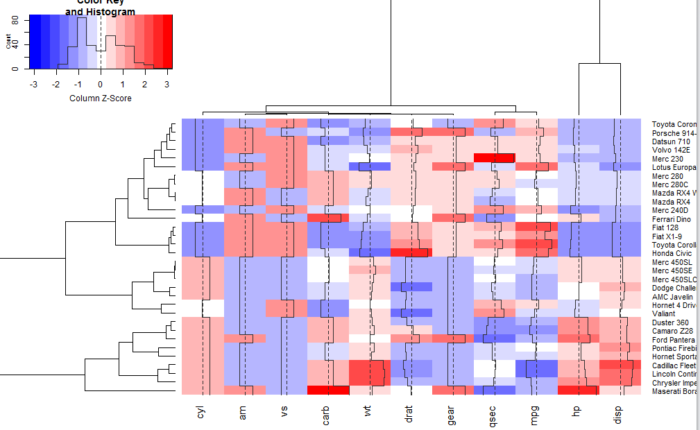数据聚类然后展示聚类热图是生物信息中组学数据分析的常用方法,在R语言中有很多函数可以实现,譬如heatmap,kmeans等,除此外还有一个用得比较多的就是heatmap.2。最近在网上看到一个笔记文章关于《一步一步学heatmap.2函数》,在此与大家分享。由于原作者不详,暂未标记来源,请原作者前来认领哦,O(∩_∩)O哈哈~
数据如下:
- library(gplots)
- data(mtcars)
- x <- as.matrix(mtcars)
- rc <- rainbow(nrow(x), start=0, end=.3)
- cc <- rainbow(ncol(x), start=0, end=.3)

X就是一个矩阵,里面是我们需要画热图的数据。
Rc是一个调色板,有32个颜色,渐进的
Cc也是一个调色板,有11个颜色,也是渐进的
首先画一个默认的图:
- heatmap.2(x)
然后可以把聚类数可以去掉:就是控制这个dendrogram参数
- heatmap.2(x, dendrogram="none")
然后我们控制一下聚类树
- heatmap.2(x, dendrogram="row") # 只显示行向量的聚类情况
- heatmap.2(x, dendrogram="col") #只显示列向量的聚类情况
下面还是在调控聚类树,但是我没看懂跟上面的参数有啥子区别!
- heatmap.2(x, keysize=2) ## default - dendrogram plotted and reordering done.
- heatmap.2(x, Rowv=FALSE, dendrogram="both") ## generate warning!
- heatmap.2(x, Rowv=NULL, dendrogram="both") ## generate warning!
- heatmap.2(x, Colv=FALSE, dendrogram="both") ## generate warning!
接下来我们可以调控行列向量的label的字体大小方向
首先我们调控列向量,也就是x轴的label
- heatmap.2(x, srtCol=NULL)
- heatmap.2(x, srtCol=0, adjCol = c(0.5,1) )
- heatmap.2(x, srtCol=45, adjCol = c(1,1) )
- heatmap.2(x, srtCol=135, adjCol = c(1,0) )
- heatmap.2(x, srtCol=180, adjCol = c(0.5,0) )
- heatmap.2(x, srtCol=225, adjCol = c(0,0) ) ## not very useful
- heatmap.2(x, srtCol=270, adjCol = c(0,0.5) )
- heatmap.2(x, srtCol=315, adjCol = c(0,1) )
- heatmap.2(x, srtCol=360, adjCol = c(0.5,1) )

然后我们调控一下行向量,也就是y轴的label
- heatmap.2(x, srtRow=45, adjRow=c(0, 1) )
- heatmap.2(x, srtRow=45, adjRow=c(0, 1), srtCol=45, adjCol=c(1,1) )
- heatmap.2(x, srtRow=45, adjRow=c(0, 1), srtCol=270, adjCol=c(0,0.5) )

设置 offsetRow/offsetCol 可以把label跟热图隔开!
- ## Show effect of offsetRow/offsetCol (only works when srtRow/srtCol is
- ## not also present) heatmap.2(x, offsetRow=0, offsetCol=0)
- heatmap.2(x, offsetRow=1, offsetCol=1)
- heatmap.2(x, offsetRow=2, offsetCol=2)
- heatmap.2(x, offsetRow=-1, offsetCol=-1)
- heatmap.2(x, srtRow=0, srtCol=90, offsetRow=0, offsetCol=0)
- heatmap.2(x, srtRow=0, srtCol=90, offsetRow=1, offsetCol=1)
- heatmap.2(x, srtRow=0, srtCol=90, offsetRow=2, offsetCol=2)
- heatmap.2(x, srtRow=0, srtCol=90, offsetRow=-1, offsetCol=-1)

- ## Show effect of z-score scaling within columns, blue-red color scale
- hv <- heatmap.2(x, col=bluered, scale="column", tracecol="#303030")
hv是一个热图对象!!!
- > names(hv) # 可以看到hv对象里面有很多子对象
- > "rowInd" "colInd" "call" "colMeans" "colSDs" "carpet" "rowDendrogram" "colDendrogram" "breaks" "col" "vline" "colorTable" ## Show the mapping of z-score values to color bins hv$colorTable
- ## Extract the range associated with white 我们得到了热图的颜色的数值映射矩阵,接下来就可以进行一系列的操作~!!!
- hv$colorTable[hv$colorTable[,"color"]=="#FFFFFF",]
首先得到了白色所对应的数值区间!
然后还可以通过一下命令,直接求出属于白色区间的那些数值。
- whiteBin <- unlist(hv$colorTable[hv$colorTable[,"color"]=="#FFFFFF",1:2])
- rbind(whiteBin[1] * hv$colSDs + hv$colMeans, whiteBin[2] * hv$colSDs + hv$colMeans )
调整scale参数选择按照列还是行来进行数据的标准化
- heatmap.2(x, col=bluered, scale="column", tracecol="#303030")
- heatmap.2(x, col=bluered, scale="row", tracecol="#303030")
如果选择了标准化,那么还可以手工调整标准化的参数:
rowMeans, rowSDs
mean and standard deviation of each row: only present if scale="row"
colMeans, colSDs
mean and standard deviation of each column: only present if scale="column"
通过hclustfun参数来调整聚类方法:参考:怎样在heatmap中使用多种cluster方法
- Cluster_Method<-c( "ward", "single", "complete", "average", "mcquitty", "median", "centroid")
- #R语言里面自带的hclust函数共有7种聚类方法
- for (i in 1:length(Cluster_Method)){
- #make a function to extract the cluster method
- myclust<-function(x){
- hclust(x,method=Cluster_Method[i])
- }
- #make heatmap by jpeg
- jpeg(filename=paste(Cluster_Method[i],'.jpg'),width=1024,height=728)
- heatmap.2(as.matrix(Data_Top1k_Var),
- trace='none',
- hclustfun=myclust,
- labRow=NA,
- ColSideColors=c('black',grey(0.4),'lightgrey')[as.factor(CellLine_Anno$Type)],
- xlab='CellLines',
- ylab='Probes',
- main=Cluster_Method[i],
- col=greenred(64))
- dev.off()
- }
这样就可以一下子把七种cluster的方法依次用到heatmap上面来。而且通过对cluster树的比较,我们可以从中挑选出最好、最稳定到cluster方法,为后续分析打好基础!
对下面这个数据聚类:
- require(graphics)
- hc <- hclust(dist(USArrests), "ave")
- plot(hc)
首先对一个数据框用dist函数处理得到一个dist对象!
Dist对象比较特殊,专门为hclust函数来画聚类树的!














1F
最近在网上看到一个笔记文章关于《一步一步学heatmap.2函数》,在此与大家分享。由于原作者不详,暂未标记来源,请原作者前来认领哦!
你们不仅大量转载我的博客文章,连我没有公开的文章都先我一步发表了。
B1
@ JImmy heatmap.2(x, dendrogram=”none”)
Error in .External.graphics(C_layout, num.rows, num.cols, mat, as.integer(num.figures), :
invalid graphics state
这个是怎么回事?